Epson EMP-730, EMP 720 User Manual
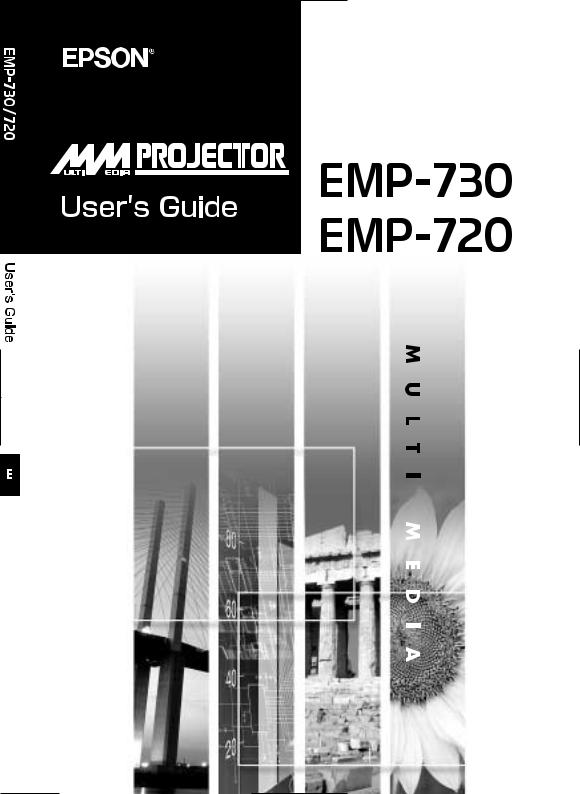
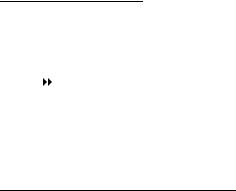
About The Manuals and Notations Used
 Types of Manual
Types of Manual
The documentation for your EPSON projector is divided into the following three manuals. The manuals cover the following topics.
 Safety Instructions/World-Wide Warranty Terms
Safety Instructions/World-Wide Warranty Terms
This manual contains information on using the projector safely, and also includes worldwide warranty terms and a troubleshooting check sheet.
Be sure to read this manual thoroughly before using the projector.
 User's Guide (this manual)
User's Guide (this manual)
This User’s Guide contains information on installing the projector, basic operation, using the configuration menus, troubleshooting and maintenance.
 Quick Reference Guide
Quick Reference Guide
Contains an overview of the most commonly-used projector functions for easy reference. You should keep this Quick Reference Guide near the projector at all times and refer to it before starting presentations and while using the projector in order to check details of operation.
 Notations Used in This User’s Guide
Notations Used in This User’s Guide
 General Information
General Information
|
Caution : |
Indicates procedures which may result in damage or injury if sufficient |
|
|
care is not taken. |
||
|
|
|
|
|
|
|
|
|
Tip : |
Indicates additional information and points which may be useful to |
|
|
know regarding a topic. |
||
|
|
|
|
|
|
|
|
|
|
|
Indicates that an explanation of the underlined word or words in front |
|
|
|
of this symbol appears in the glossary of terms. |
|
|
|
Refer to the "Glossary" in the "Appendices". (p.83) |
|
|
|
|
|
|
|
Indicates operating methods and the order of operations. |
|
Procedure |
|
|
|
|
The procedure indicated should be carried out in the order of the |
|
|
|
|
numbers. |
|
|
|
|
 Meaning of "unit" and "projector"
Meaning of "unit" and "projector"
When "unit" or "projector" appears in the text of this User’s Guide, it may refer to items which are accessories or optional equipment in addition to the main projector unit itself.
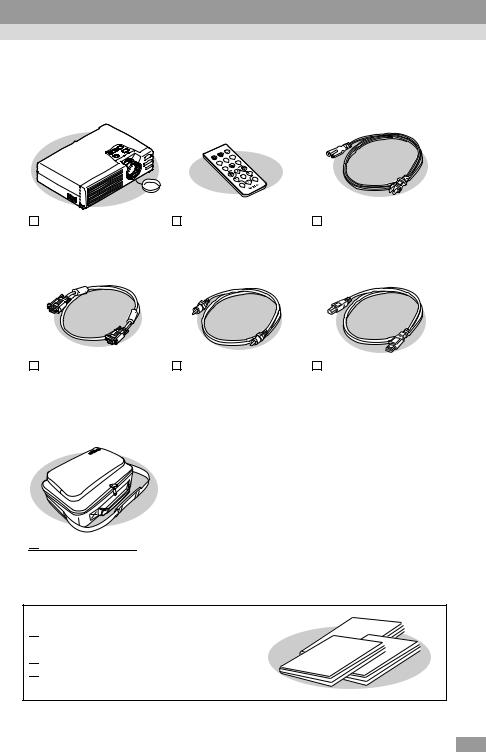
 Unpacking the Projector
Unpacking the Projector
When you unpack the projector, make sure that you have all these components. If any of the components are missing or incorrect, please contact the place of purchase.
up |
Power |
Page |
|
down |
Mode |
Page |
Color |
S-Video/Video |
|
Computer |
A/VMute |
|
|
Freeze
Menu
E-Zoom
Enter
ESC
Auto
Projector |
|
Remote control |
|
Power cable |
|
(with lens cover) |
(including a CR2025 lithium |
(1.8 m (6 ft.)) |
|||
|
|
battery) |
For connecting the projector |
||
|
|
|
|
to a wall outlet |
|
Computer cable |
|
RCA video cable |
|
USB cable |
|
|
|
|
|
|
|
(mini D-Sub 15-pin/mini D- |
(1.8 m (6 ft.)) |
(1.8 m (6 ft.)) |
|||
Sub 15-pin 1.8 m (6 ft.)) |
For connecting the projector |
For connecting the projector |
|||
For connecting the projector |
to a video component |
to a computer with a USB |
|||
to a computer |
|
|
port so that the wireless |
||
|
|
|
|
mouse function can be used |
|

 Soft carrying case
Soft carrying case
(with shoulder strap and handle)
For carrying the projector
Documentation

 Safety Instructions/
Safety Instructions/
World-Wide Warranty Terms

 User's Guide (this manual)
User's Guide (this manual)

 Quick Reference Guide
Quick Reference Guide
1

 Features of the Projector
Features of the Projector
 Automatic keystone correction function
Automatic keystone correction function
The vertical angle of the projector is detected, so that any vertical keystone distortion in the projected images can be automatically corrected. (p.34)
 Automatic setup function
Automatic setup function
When projecting computer images, the signals from the connected computer are detected automatically and adjusted so that the optimum images are projected. Even if several people are giving presentations using the same projector, the optimum picture quality can be obtained simply by disconnecting and reconnecting the computers. Each individual setting can also be adjusted manually. (p.37)
 Color mode function
Color mode function
The optimum images can be projected simply by selecting the image quality from the following six preset settings according to the projection environment being used.
No other troublesome colour adjustments are necessary. (p.40, 47, 49)
• sRGB |
• Normal |
• Meeting |
||
• |
|
|
• Theatre |
• Game |
Presentation |
||||
Compact and lightweight
The projector has a compact body with a footprint the size of a B5 page
(19 (D) x 27.6 (W) x 7 (H) cm (7.5 (D) x 10.9 (w) x 2.8 (H))) and is light in weight (approximately 1.9 kg. (4.2 lbs)), making it easy to carry.
 Brilliant, attractive images
Brilliant, attractive images
Despite its compact size, the projector can display images at high resolutions with a high degree of luminance, providing beautifully clear images even in bright environments.
Easy to Operate
The accessory remote control can be used for operations such as pausing projection (see "Freeze" on p.43) and zooming in on important areas of an image
(see "E-Zoom" on p.45). In addition, the remote control can be used to move the pointer around on the computer screen during projection (see "Wireless Mouse Function" on p.21). If using the wireless mouse function, you can use the remote control to scroll back and forth through pages when projecting a PowerPoint presentation.
2
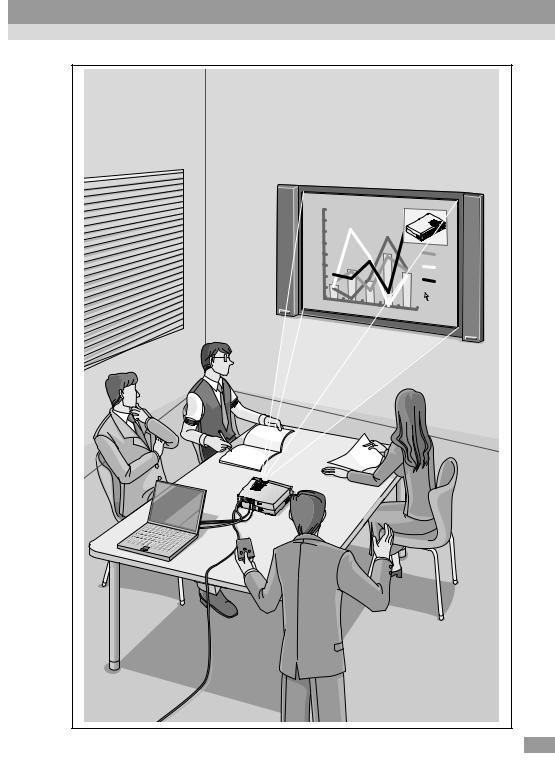
80 |
projector |
|
|
|
|
70 |
|
|
|
|
|
60 |
|
|
|
|
|
50 |
|
|
|
|
|
40 |
|
|
|
|
C |
30 |
|
|
|
|
B |
|
|
|
|
|
|
20 |
|
|
|
|
A |
10 |
|
|
|
|
|
|
|
|
|
|
|
0 |
Jan |
|
|
|
|
|
Feb |
Mar |
|
|
|
|
|
Jun |
|
||
|
|
|
Jul |
||
|
|
|
|
||
|
|
|
|
|
|
3

 Contents
Contents
Unpacking the Projector.................................................................... |
1 |
Features of the Projector................................................................... |
2 |
Before Using the Projector |
|
Part Names and Functions ............................................................... |
8 |
Front/Top................................................................................................ |
8 |
Control Panel.......................................................................................... |
9 |
Rear ...................................................................................................... |
10 |
Base...................................................................................................... |
10 |
Remote Control .................................................................................... |
11 |
Before Using the Remote Control ................................................... |
12 |
Using the Remote Control and Remote Operating Range ................... |
12 |
Installation....................................................................................... |
14 |
Setting Up the Projector....................................................................... |
14 |
Screen Size and Projection Distance.................................................... |
15 |
Connecting to a Computer .............................................................. |
16 |
Eligible Computers .............................................................................. |
16 |
Projecting Images from the Computer ................................................. |
17 |
Playing Sound from the Computer ...................................................... |
20 |
Using the Remote Control to Operate the Mouse Pointer |
|
(Wireless Mouse Function) ................................................................ |
21 |
Connecting to a Video Source ........................................................ |
23 |
Projecting Composite Video Images.................................................... |
23 |
Projecting S-Video Images................................................................... |
24 |
Projecting Component Video Images .................................................. |
24 |
Projecting RGB Video Images............................................................. |
25 |
Playing Sound from the Video Equipment .......................................... |
26 |
Basic Operations |
|
Turning On the Projector ................................................................. |
28 |
Connecting the Power Cable................................................................ |
28 |
Turning On the Power and Projecting Images ..................................... |
29 |
Turning Off the Projector ................................................................. |
31 |
Adjusting the Screen Image............................................................ |
33 |
Adjusting the Image Size ..................................................................... |
33 |
Adjusting the Image Angle and |
|
Automatic Keystone Correction Function.......................................... |
34 |
Manually Correcting Keystone Distortion ........................................... |
36 |
4

Adjusting the Image Quality ............................................................ |
37 |
Focusing the Screen Image .................................................................. |
37 |
Adjusting Computer Images ................................................................ |
37 |
Selecting the Colour Mode .................................................................. |
40 |
Advanced Operations |
|
Functions for Enhancing Projection ................................................ |
42 |
A/V Mute ............................................................................................. |
42 |
Freeze................................................................................................... |
43 |
Wide-screen Projection of Component Video and Video Images |
|
(Changing the Aspect Ratio) ............................................................. |
44 |
E-Zoom ................................................................................................ |
45 |
Using the Configuration Menu Functions ........................................ |
46 |
List of Functions .................................................................................. |
46 |
Using the Configuration Menus........................................................... |
56 |
Before Using |
the Projector |
Basic Operations |
|
Troubleshooting |
|
Using the Help ................................................................................ |
60 |
When Having Some Trouble............................................................ |
61 |
Power Indicator.................................................................................... |
61 |
(Warning) Indicator...................................................................... |
62 |
When the Indicators Provide No Help ............................................. |
64 |
Appendices |
|
Advanced Operations
Maintenance ................................................................................... |
72 |
Cleaning ............................................................................................... |
72 |
Replacing Consumables....................................................................... |
74 |
Saving a User's Logo ...................................................................... |
80 |
Optional Accessories ...................................................................... |
82 |
Glossary.......................................................................................... |
83 |
List of ESC/VP21 Commands......................................................... |
86 |
Command List...................................................................................... |
86 |
USB Connection Setup ........................................................................ |
87 |
List of Supported Monitor Displays ................................................. |
88 |
Specifications.................................................................................. |
89 |
Appearance..................................................................................... |
91 |
Index ............................................................................................... |
92 |
Appendices Troubleshooting
5

Before Using the Projector
This chapter describes the procedures for setting up the projector before use.
Part Names and Functions ................................................. |
8 |
• Front/Top ................................................................................................ |
8 |
• Control Panel.......................................................................................... |
9 |
• Rear....................................................................................................... |
10 |
• Base ....................................................................................................... |
10 |
• Remote Control .................................................................................... |
11 |
Before Using the Remote Control .................................... |
12 |
• Using the Remote Control and Remote Operating Range............... |
12 |
Installation ......................................................................... |
14 |
• Setting Up the Projector...................................................................... |
14 |
• Screen Size and Projection Distance .................................................. |
15 |
Connecting to a Computer ............................................... |
16 |
• Eligible Computers .............................................................................. |
16 |
• Projecting Images from the Computer .............................................. |
17 |
• If the Monitor Port is a Mini D-Sub 15-pin Port .............................................. |
17 |
• If the Monitor Port is a 5BNC Port ................................................................... |
18 |
• If the Monitor Port is a 13w3 Port .................................................................... |
19 |
• Playing Sound from the Computer .................................................... |
20 |
• Using the Remote Control to Operate the Mouse Pointer |
|
(Wireless Mouse Function)................................................................. |
21 |
Connecting to a Video Source ......................................... |
23 |
• Projecting Composite Video Images .................................................. |
23 |
• Projecting S-Video Images .................................................................. |
24 |
• Projecting Component Video Images................................................. |
24 |
• Projecting RGB Video Images............................................................ |
25 |
• Playing Sound from the Video Equipment........................................ |
26 |
7
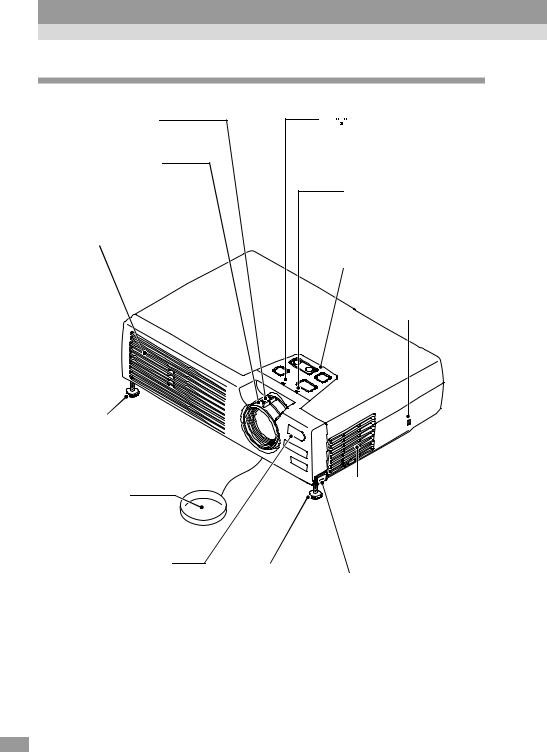
 Part Names and Functions
Part Names and Functions
Front/Top
•Zoom ring (p.33)
Adjusts the image size.
•Focus ring (p.37)
Adjusts the image focus.
•Air exhaust vent
•Front adjustable foot (p.34)
Extend and retract to adjust the projection angle.
•Lens cover
Attach when not using the projector to prevent the lens from becoming dirty or damaged.
•Remote control lightreceiving area (p.12)
Receives signals from the remote control.
• 


 (Warning) indicator (p.62)
(Warning) indicator (p.62)
Flashes or lights in different colours to indicate problems with the projector or that the projection lamp needs to be replaced.
•Power indicator (p.61)
Flashes or lights in different colours to indicate the operating status of the projector.
•Control panel (p.9)
•Security lock (  ) (p.84)
) (p.84)
•Front adjustable foot (p.34)
Extend and retract to adjust the projection angle.
•Air filter (air intake vent) (p.73, 79)
Prevents dust and other foreign particles from being drawn into the projector. When replacing the lamp, replace the air filter also.
•Foot adjust button (p.35)
Another foot adjust button is located on the right side. Press both foot adjust buttons when extending and retracting the front adjustable feet.
8
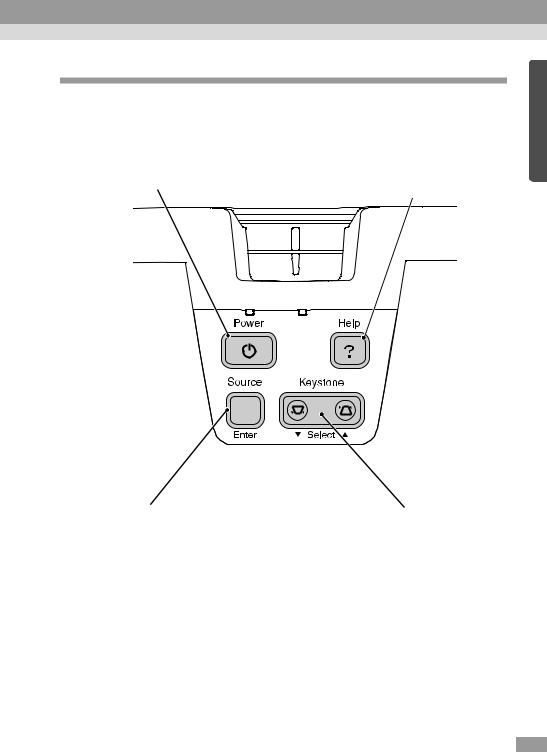
Control Panel
•[Power] button (p.29, 31)
Turns the projector power on and off.
•[Source] button (p.30)
Switches the input source between the Computer/Component Video port, S- Video port and Video port each time the button is pressed.
When pressed while a help menu is being displayed, it accepts the menu item that is currently selected. (p.60)
•[Help] button (p.60)
Displays the online help menu to assist you if you have a problem.
•[Keystone] button (p.36)
Press to manually correct keystone distortion in images. When pressed while a help menu is being displayed, it selects items in the menu. (p.60)
9
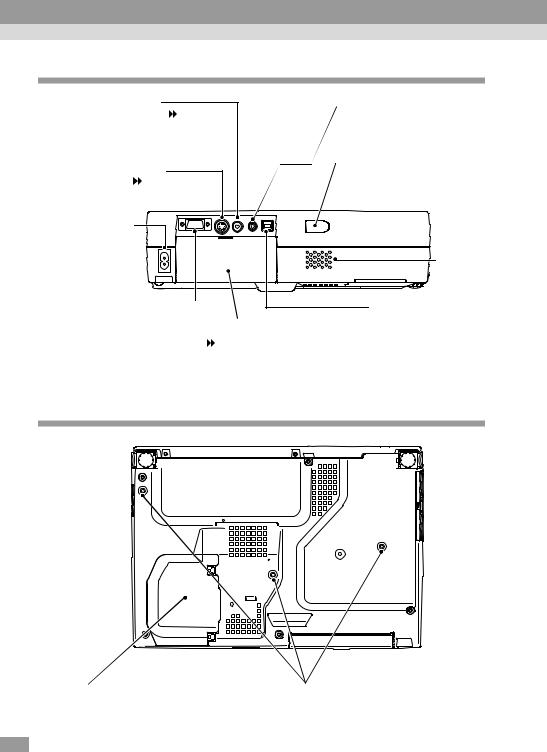
Part Names and Functions
Rear
• Video port (p.23) |
• Audio-In port (p.20, 26) |
||
Inputs composite video signals to |
Inputs audio signals. |
||
the projector from other video sources. |
Connect using a stereo mini |
||
Use the RCA video cable for this |
jack. |
|
|
connection. |
• Remote control light- |
||
• S-Video port (p.24) |
receiving area (p.12) |
||
Inputs S-Video signals to the |
Receives signals from the |
||
projector from other video sources. |
remote control. |
||
• Power inlet |
|
|
|
(p.28) |
|
|
|
Connects the |
|
• Speaker |
|
power cable. |
|
||
|
|
||
• Computer/Component Video |
• Remote control holder |
• USB port (p.21) |
|
port (p.17, 24, 25) |
Connects the projector |
||
Inputs analogue video signals from |
(p.12) |
to a computer via the |
|
a computer and component video |
USB cable. |
||
Store the accessory remote |
|||
signals from other video sources. |
control in here when not |
|
|
|
using it. |
|
|
Base
• Lamp cover (p.76) |
• Suspension bracket fixing points (3 points) |
Open this cover when replacing the |
(p.14, 82) |
lamp inside the projector. |
Install the optional ceiling mount here when |
|
suspending the projector from the ceiling. |
10
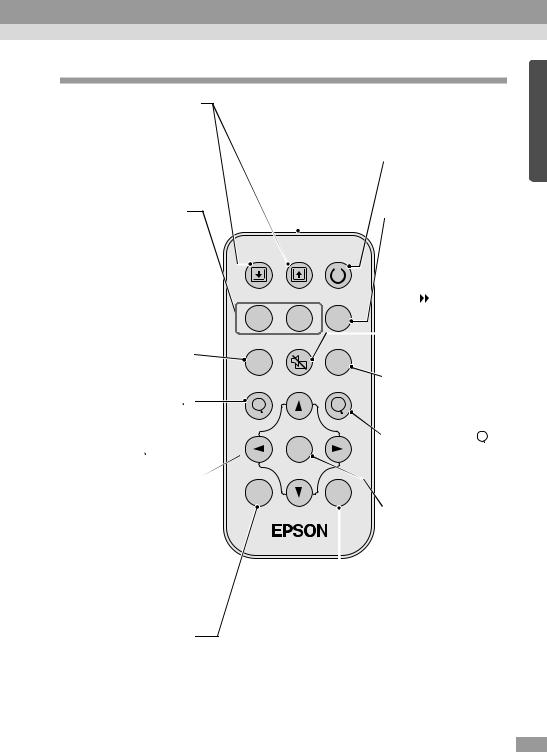
Remote Control
•[Page down]/[Page up] buttons (p.21)
When using the remote control as a wireless mouse, press these buttons to scroll back and forth through pages when projecting a PowerPoint presentation.
•Input select buttons (p.30)
[Computer]: Switches the signal source to the images being input from the Computer/Component Video port. [S-Video/Video]: Switches the signal source being input from the S-Video port and the Video port.
•[Menu] button (p.56)
Displays or hides the configuration menus.
•[E-Zoom] button (  ) (p.45)
) (p.45)
Reduces the part of images
that have been enlarged using the [  ] button.
] button.
•[ ][
][ ][
][ ][
][ ] buttons
] buttons  (p.22, 56, 60)
(p.22, 56, 60)
When using the remote control as a wireless mouse, these buttons move the pointer in the direction corresponding to the button that was pressed.
When a configuration menu or help menu is displayed, these buttons select menu items and setting values.
• [Auto] button (p.37)
Use this button to automatically adjust computer images to the optimum images when automatic setup has been set to "OFF".
•Remote control lightemitting area (p.13)
|
|
Outputs remote control |
|
|
|
|
|
||||||||||
|
|
signals. |
|
|
|
|
|
|
• [Power] button |
||||||||
|
|
|
|
|
|
|
|
|
|
|
|
|
|||||
|
|
|
|
|
|
|
|
|
|
|
|
|
|||||
|
|
|
|
|
|
|
|
|
|
|
|
|
(p.29, 31) |
||||
|
|
|
|
|
|
|
|
|
|
|
|
|
Turns the projector power |
||||
|
|
|
|
|
|
|
|
|
|
|
|
|
on and off. |
||||
|
|
|
|
|
|
|
|
|
|
|
|
|
• [Color Mode] button |
||||
|
|
|
|
|
|
|
|
|
|
|
|
|
(p.40) |
||||
|
|
|
|
|
|
|
|
Power |
Selects the colour mode. |
||||||||
Page down |
Page up |
|
The colour mode changes |
||||||||||||||
|
|
|
|
|
|
|
|
|
|
|
|
|
in the order of Normal, |
||||
|
|
|
|
|
|
|
|
|
|
|
|
|
Meeting, Presentation, |
||||
|
|
|
|
|
|
|
|
|
|
|
|
|
|||||
Computer |
S-Video/Video Color Mode |
Theatre, Game and |
|||||||||||||||
sRGB each time the |
|||||||||||||||||
|
|
|
|
|
|
|
|
|
|
|
|
|
button is pressed. |
||||
|
|
|
|
|
|
|
|
|
|
|
|
|
• [A/V Mute] button (p.42) |
||||
Menu |
A/V Mute |
|
|
Freeze |
|||||||||||||
|
|
Momentarily turns off the |
|||||||||||||||
|
|
|
|
|
|
|
|
|
|
|
|
|
|||||
|
|
|
|
|
|
|
|
|
|
|
|
|
audio and video. |
||||
|
|
|
|
|
|
|
|
|
|
|
|
|
|||||
|
|
|
|
|
E-Zoom |
|
|
|
|
|
|
• [Freeze] button (p.43) |
|||||
|
|
|
|
|
|
|
|
|
|
|
|||||||
|
|
|
|
|
|
|
|
|
|
|
Keeps the current |
||||||
|
|
|
|
|
|
|
|
|
|
|
|
|
|||||
|
|
|
|
|
|
|
|
|
|
|
|
|
computer or video image |
||||
|
|
|
|
|
|
|
|
|
|
|
|
|
on the screen. |
||||
|
|
|
|
|
Enter |
|
|
|
|
|
|
• [E-Zoom] button ( |
|
|
|
) |
|
|
|
|
|
|
|
|
|
|
|
|
(p.45) |
||||||
|
|
|
|
|
|
|
|
|
|
|
|
|
Enlarges the part of images |
||||
|
|
|
|
|
|
|
|
|
|
|
|
|
without changing the size |
||||
|
Auto |
|
|
|
|
ESC |
of the projection area. |
||||||||||
|
|
|
|
|
• [Enter] button |
||||||||||||
|
|
|
|
|
|
|
|
|
|
|
|
|
|||||
|
|
|
|
|
|
|
|
|
|
|
|
|
|||||
|
|
|
|
|
|
|
|
|
|
|
|
|
(p.22, 56, 60) |
||||
|
|
|
|
|
|
|
|
|
|
|
|
|
Accepts a menu item or |
||||
|
|
|
|
|
|
|
|
|
|
|
|
|
displays the next screen or |
||||
|
|
|
|
|
|
|
|
|
|
|
|
|
menu while viewing a |
||||
|
|
|
|
|
|
|
|
|
|
|
|
|
configuration menu or |
||||
|
|
|
|
|
|
|
|
|
|
|
|
|
help menu. |
||||
• [ESC] button (p.22, |
|
|
|
Acts as a mouse left-click |
|||||||||||||
57) |
|
when using the remote |
|||||||||||||||
Stops the current function. |
control as a wireless |
||||||||||||||||
Displays the previous |
mouse. |
||||||||||||||||
screen or menu while |
|
|
|
|
|
||||||||||||
viewing a configuration |
|
|
|
|
|
||||||||||||
menu.
Acts as a mouse right-click when using the remote control as a wireless mouse.
11

 Before Using the Remote Control
Before Using the Remote Control
Using the Remote Control and Remote Operating Range
When using the remote control for the first time, pull out the insulating tape that is protruding from the battery holder. When the insulating tape is pulled out, the remote control can then be used.
 Using the Remote Control
Using the Remote Control
The remote control is used in the following way.
Procedure
Point the remote control light-emitting area toward one of the remote control light-receiving areas on the projector and operate the remote control buttons.
Remote control |
Remote control |
Remote control |
light-receiving |
light-emitting area |
light-receiving |
Power |
|
Power |
area (front) |
|
area (back) |
Tip :
•Do not allow sunlight or light from fluorescent lamps to shine directly onto the projector's remote control light-receiving areas, otherwise it may interfere with the reception of signals from the remote control.
•If delays in the responsiveness of the remote control occur or if it does not operate after it has been used for some time, it probably means that the battery is getting flat. If this happens, replace the battery with a new one. (p.74)
•When not using the remote control, place it into the remote control holder at the back of the projector so that it does not get lost.
12

 Remote Operating Range
Remote Operating Range
Use the remote control within the ranges indicated below. If the distance or angle between the remote control and the remote control light-receiving area is outside the normal operating range, the remote control may not work.
Operating distance |
Operating angle |
|
Approx. 6 m (20 ft.) |
Approx. 30º horizontally |
|
Approx. 15º vertically |
||
|
||
Approx. 30º horizontally |
Remote control |
|
|
||
|
light-receiving |
|
|
area |
Within approx. 6 m (20ft.)
Approx. 30º Approx. 30º |
Approx. 30º |
Approx. 30º |
Power |
|
Power |
Remote control |
|
|
light-emitting area |
|
|
Approx. 15º vertically
Approx. 15º |
Approx. 15º |
When suspended from the ceiling
Approx. 15º |
Approx. 15º |
13
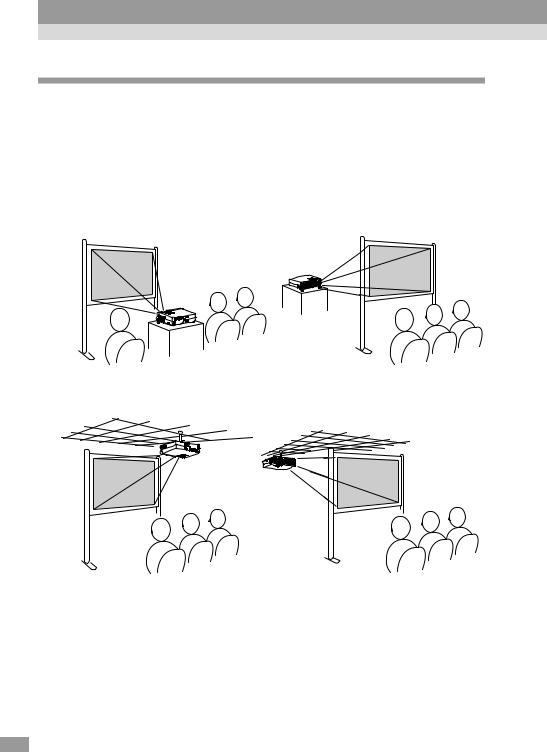
 Installation
Installation
Setting Up the Projector
The projector supports the following four different projection methods, allowing you to choose the best method for displaying your images.
Caution :
Before setting up the projector, be sure to first read the separate Safety Instructions/ World-Wide Warranty Terms.
• Front projection |
• Rear projection using a translucent |
|
screen |
• Front/ceiling projection |
|
• Rear/ceiling projection using a |
|||||||||||
|
|
|
|
|
|
|
|
|
translucent screen |
||||
|
|
|
|
|
|
|
|
|
|
|
|
|
|
|
|
|
|
|
|
|
|
|
|
|
|
|
|
|
|
|
|
|
|
|
|
|
|
|
|
|
|
|
|
|
|
|
|
|
|
|
|
|
|
|
|
*A special method of installation is required in order to suspend the projector from the ceiling. Please contact the place of purchase if you would like to use this installation method. The optional ceiling mount is required when installing the projector to the ceiling. (p.82)
Tip :
When using rear/ceiling projection using a translucent screen, set the "Ceiling" or "Rear Proj." command in the "Advanced" menu to match the installation method. (p.53)
14
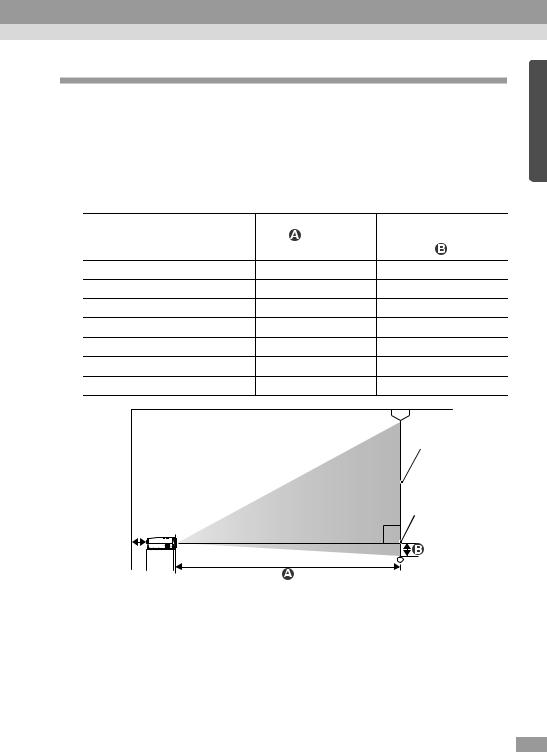
Screen Size and Projection Distance
The distance between the projector and the screen determines the actual image size.
Recommended distance |
1.0–11.7 m (3.2–38.5 ft.) |
|
|
While referring to the table below, position the projector so that the images are projected onto the screen at the optimum size.
The values should be used as a guide for setting up the projector. The actual values will vary depending on projection conditions and the zoom setting.
4:3 Screen size |
Projection distance |
Distance from center |
|
(cm (in.)) |
(m (ft.)) |
of lens to bottom edge |
|
|
|
of screen |
(cm (in.)) |
30" (61 |
× 46 (24.0 × 18.1)) |
1.0−1.1 |
(3.2–3.7) |
4.6 |
(1.8) |
|
40" (81 |
× 61 (31.9 × 24.0)) |
1.3−1.5 |
(4.3–5.0) |
6.1 |
(2.4) |
|
60" (120 × 90 (47.2 × 35.4) |
2.0−2.3 |
(6.5–7.5) |
9.1 |
(3.6) |
||
80" (160 |
× 120 (63.0 × 47.2)) |
2.7−3.1 (8.7–10.1) |
12.2 (4.8) |
|||
100" (200 × 150 (78.7 |
× 59.1)) |
3.3−3.9 (11.0–12.7) |
15.2 (6.0) |
|||
200" (410 × 300 (161.4 |
× 118.1)) |
6.7−7.8 (22.1–25.6) |
30.5 |
(12.0) |
||
300" (610 × 460 (240.2 |
× 181.1)) |
10.1−11.7 |
(33.2–38.5) |
45.7 |
(18.0) |
|
|
|
|
|
|
Screen |
|
|
|
|
|
|
Centre of lens |
|
|
|
|
|
|
90º |
|
* |
|
|
|
|
|
|
*When installing against a wall, leave a space of about 20 cm (7.9 in.) between the projector and the wall.
Tip :
•The projector's lens allows a zoom ratio of up to about 1.16. The image size at the maximum zoom setting is about 1.16 times bigger than the image size at the minimum zoom setting.
•The image size will be reduced when keystone correction is carried out.
15

 Connecting to a Computer
Connecting to a Computer
Caution :
When connecting the projector to a computer, be sure to check the following.
•Turn off the power for both the projector and the computer before connecting them. If the power for either device is on at the time of connection, damage may result.
•Check the shapes of the cable connectors and the device ports before making the connections. If you try to force a connector to fit a device port with a different shape or number of terminals, damage to the connector or port may result.
Eligible Computers
The projector cannot be connected to some types of computer, or projection of images may not be possible even if actual connection is possible. Make sure that the computer you intend to use satisfies the conditions given below.
•Condition 1: The computer must have an image signal output port.
Check that the computer has a port such as an "RGB port", "monitor port" or "CRT port" which can output image signals.
If the computer has a built-in monitor, or if using a laptop computer, it may not be possible to connect the computer to the projector, or alternatively you may need to purchase a separate external output port. Refer to the documentation for your computer under a heading such as "Connecting an external monitor" or similar for further details.
•Condition 2: The display resolution and frequency of the computer must be listed in the "List of Supported Monitor Displays". See "Appendices: List of Supported Monitor Displays"(p.88).
Some computers allow you to change the output resolution, so if necessary, change the resolution to one that matches a setting in the "List of Supported Monitor Displays", while referring to the documentation provided with the computer.
Tip :
•You may need to purchase a separate adapter depending on the shape of the computer's port. Refer to the documentation provided with the computer for further details.
•If the computer and projector are too far away from each other for the accessory computer cable to reach, use the optional VGA-HD15 PC cable. See "Appendices: Optional Accessories" (p.82)
16

Projecting Images from the Computer
The shape and specifications of the computer's monitor port will determine what type of cable should be used. Check the following to see which type of port your computer has.
 If the Monitor Port is a Mini D-Sub 15-pin Port
If the Monitor Port is a Mini D-Sub 15-pin Port
Use the accessory computer cable to connect the Computer/Component Video port at the rear of the projector to the monitor port of the computer.
To monitor port
Computer cable |
To Computer/ |
(accessory) |
Component Video port |
Tip :
•Change the "Input Signal" setting in the "Video" menu to "RGB" after making the connections. (p.47)
•If more than one external component is connected to the projector, use the [Source] button on the projector's control panel or the [Computer] button on the remote control to select the Computer port as the input source. (p.30)
•Do not bind the power cable and the computer cable together, otherwise image interference or errors in operation may result.
17
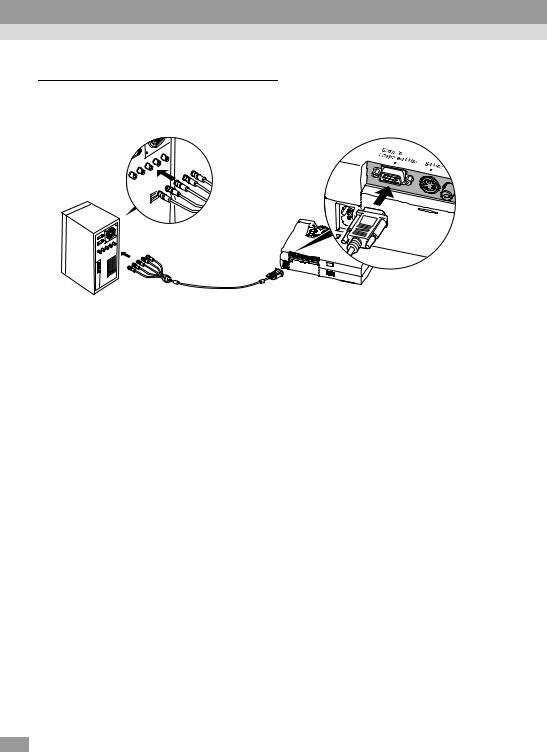
Connecting to a Computer
 If the Monitor Port is a 5BNC
If the Monitor Port is a 5BNC Port
Port
Use the optional VGA-HD15 PC cable to connect the Computer/Component Video port at the rear of the projector to the monitor port of the computer. See "Appendices: Optional Accessories" (p.82)
To monitor port
|
To Computer/ |
VGA-HD15 PC cable |
Component Video port |
|
|
(optional) |
|
Tip :
•Change the "Input Signal" setting in the "Video" menu to "RGB" after making the connections. (p.47)
•If more than one external component is connected to the projector, use the [Source] button on the projector's control panel or the [Computer] button on the remote control to select the Computer port as the input source. (p.30)
•Do not bind the power cable and the computer cable together, otherwise image interference or errors in operation may result.
18
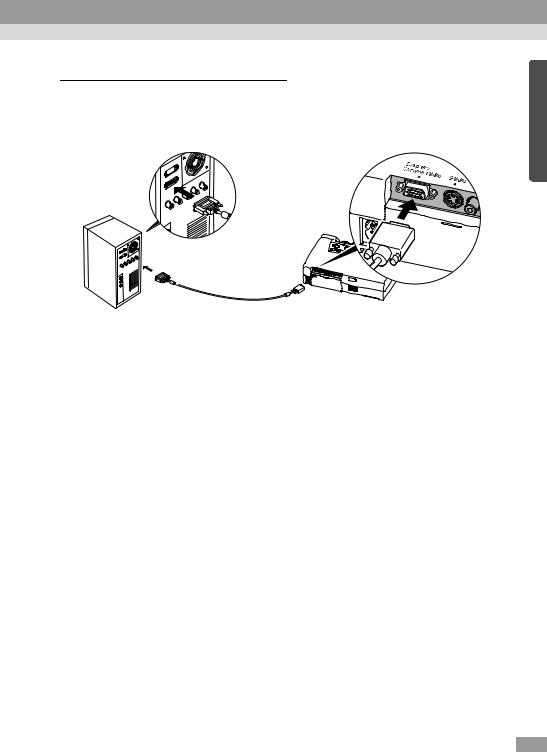
 If the Monitor Port is a 13w3 Port
If the Monitor Port is a 13w3 Port
Some workstation-type computers have a 13w3 monitor port.
Use a commercially-available 13w3 D-Sub 15-pin cable to connect the Computer/Component Video port at the rear of the projector to the monitor port of the computer.
To monitor port |
|
|
To Computer/ |
13w3 cable |
Component Video port |
(commercially-available) |
|
Tip :
•Change the "Input Signal" setting in the "Video" menu to "RGB" after making the connections. (p.47)
•If more than one external component is connected to the projector, use the [Source] button on the projector's control panel or the [Computer] button on the remote control to select the Computer port as the input source. (p.30)
•Do not bind the power cable and the computer cable together, otherwise image interference or errors in operation may result.
•Some workstations may require a special cable. Consult the workstation manufacturer for further details.
19
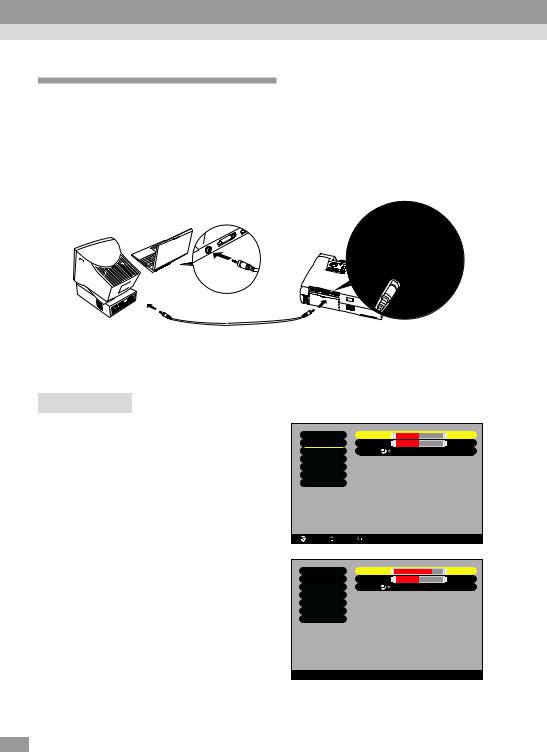
Connecting to a Computer
Playing Sound from the Computer
The projector has a single built-in speaker with a maximum output of 1 W. If the computer that is connected to the projector has an audio output port, you can output sound from the computer through the projector's speaker by connecting the computer's audio output port and the Audio-In port (stereo mini jack) on the rear of the projector using a stereo mini jack audio cable (commercially-available). It is recommended that you use an audio cable with a 3.5 mm diameter stereo mini jack.
To audio output port |
Stereo mini jack audio cable |
To Audio-In port |
|
||
|
(commercially-available) |
|
Use the following procedure to adjust the volume of the sound output.
Procedure
1 Press the [Menu] button on the remote control, and then select "Volume" from the "Audio" menu.
For details on this operation, refer to "Using the Configuration Menus". (p.56)
2 Use the [ ] and [
] and [ ] buttons to adjust the volume.
] buttons to adjust the volume.
The volume is increased or reduced each time a button is pressed.
Video |
|
Volume : |
10 - |
+ |
|
Audio |
|
Tone |
: |
0 - |
+ |
Setting |
|
Reset |
|
Execute |
|
User's Logo |
|
|
|
|
|
Advanced |
|
|
|
|
|
About |
|
|
|
|
|
Reset All |
|
|
|
|
|
: Return |
: Select |
: Adjust |
|
|
|
Video |
|
Volume : |
15 - |
+ |
|
Audio |
|
Tone |
: |
0 - |
+ |
Setting |
|
Reset |
Execute |
User's Logo |
|
|
|
Advanced |
|
|
|
About |
|
|
|
Reset All |
|
|
|
 : Return
: Return : Select
: Select  : Adjust
: Adjust
3 After making the adjustment, press the [Menu] button to exit the configuration menu.
20
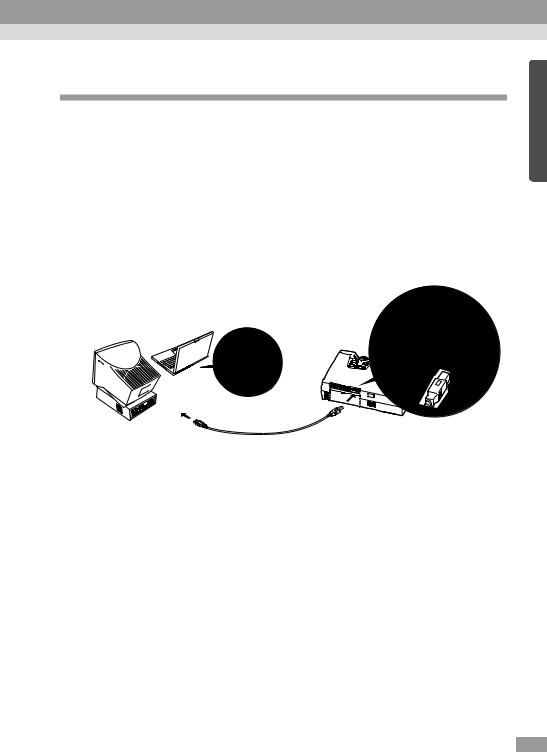
Using the Remote Control to Operate the Mouse Pointer (Wireless Mouse Function)
You can use the remote control as a wireless mouse to control the mouse pointer on the computer screen. To do this, you must use the accessory USB cable to connect the USB port of the computer to the USB port at the rear of the projector.
cable to connect the USB port of the computer to the USB port at the rear of the projector.
Computer |
Mouse used |
Applicable cable |
|
Windows 98/2000/Me/ |
|
|
|
XP Home Edition/ |
USB mouse |
USB cable (accessory) |
|
XP Professional |
|
|
|
Macintosh |
USB mouse |
USB cable (accessory) |
|
(OS 8.6 - 9.2/X/10.1) |
|||
|
|
To USB port |
To USB port |
|
USB cable (accessory)
*When using the remote control as a wireless mouse, the [Page down] and [Page up] buttons on the remote control can be used to scroll back and forth through pages when projecting a PowerPoint presentation.
Tip :
•The USB cable can only be connected to computers with a standard USB interface. If using a computer which is running Windows, the computer must have had a full version of Windows 98/2000/Me/XP Home Edition/XP Professional installed. If the computer is running a version of Windows 98/2000/Me/XP Home Edition/XP Professional that has been upgraded from an earlier version of Windows, correct operation cannot be guaranteed.
•It may not be possible to use the mouse function under some versions of both the Windows and Macintosh operating systems.
•Some computer settings may have to be changed in order for the mouse function to be used. Consult the documentation for the computer for further details.
21

Connecting to a Computer
Once the connection has been made, the mouse pointer can be operated as follows.
Moving the mouse pointer |
Left click |
|
|
||
Press the [ |
], [ |
], [ ] or [ ] button to |
Press the [Enter] button. |
||
move the mouse pointer in the direction of |
If you press the [Enter] button twice in |
||||
the button pressed. |
rapid succession, it has the effect of a |
||||
|
|
|
double-click. |
|
|
Page down Page up Power |
Page down Page up |
Power |
|||
Computer S-Video/Video Color Mode |
Computer S-Video/Video |
Color Mode |
|||
Menu A/V Mute Freeze |
Menu |
A/V Mute |
Freeze |
||
E-Zoom |
|
|
E-Zoom |
|
|
Enter |
|
|
Enter |
|
|
Auto |
ESC |
|
Auto |
|
ESC |
Right click |
|
|
Drag and drop |
||
Press the [ESC] button. |
While holding down the [Enter] button, |
||||
|
|
|
press the [ |
], [ |
], [ ] or [ ] button to |
|
|
|
drag items. Release the [Enter] button to |
||
|
|
|
drop the items being dragged at the |
||
|
|
|
desired position. |
||
Page down Page up |
Power |
Page down Page up Power |
|||
Computer |
S-Video/Video |
Color Mode |
Computer S-Video/Video Color Mode |
||
Menu |
A/V Mute |
Freeze |
Menu A/V Mute Freeze |
||
|
E-Zoom |
|
E-Zoom |
|
|
|
Enter |
|
|
Enter |
|
Auto |
|
ESC |
Auto |
ESC |
|
Tip :
•If the mouse button settings have been reversed at the computer, the operation of the remote control buttons will also be reversed.
•The wireless mouse function cannot be used while a configuration menu or help menu is being displayed or while the E-Zoom function is being used.
22
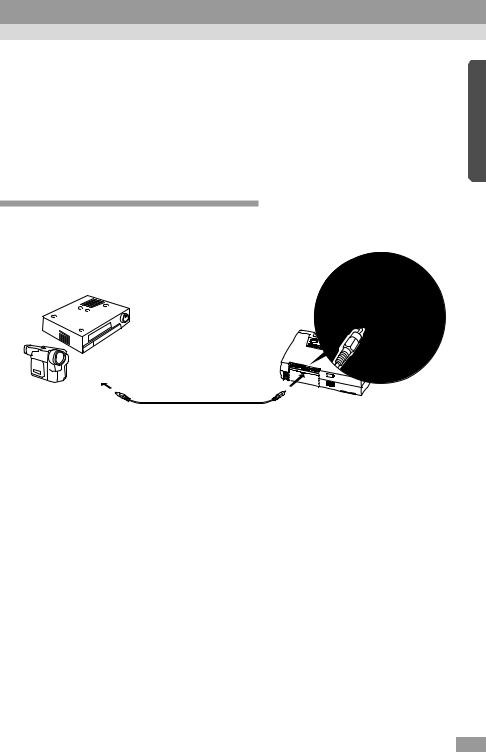
 Connecting to a Video Source
Connecting to a Video Source
Caution :
When connecting the projector to other video sources, take the following precautions.
•Turn off the power for both the projector and the video source before connecting them. If the power for either device is on at the time of connection, damage may result.
•Check the shapes of the cable connectors and the device ports before making the connections. If you try to force a connector to fit a device port with a different shape or number of terminals, a malfunction or damage to the connector or port may result.
Projecting Composite Video Images
Images
Use the accessory RCA video cable to connect the video source to the Video port at the rear of the projector.
To video output port (yellow)
To Video port
RCA video cable (accessory)
Tip :
If more than one external component is connected to the projector, use the [Source] button on the projector's control panel or the [S-Video/Video] button on the remote control to select the Video port as the input source. (p.30)
23
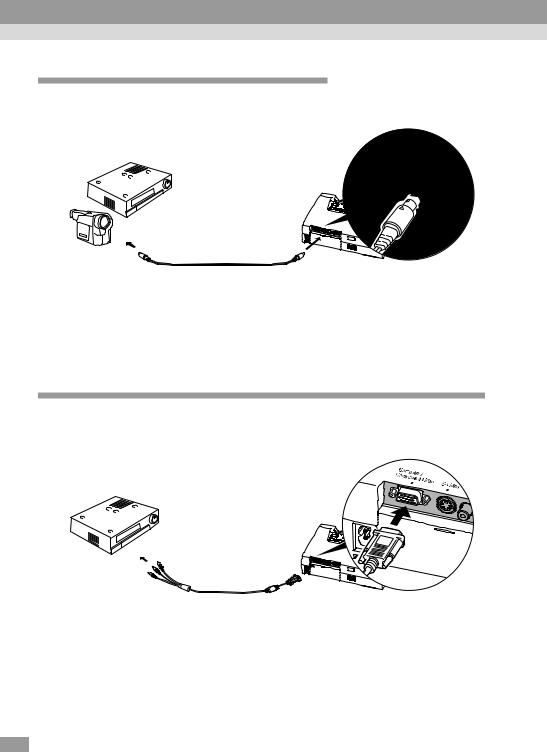
Connecting to a Video Source
Projecting S-Video Images
Images
Use a S-Video cable (commercially-available) to connect the video source to the S-Video port at the rear of the projector.
To video output port
S-Video cable To S-Video port (commercially-available)
Tip :
If more than one external component is connected to the projector, use the [Source] button on the projector's control panel or the [S-Video/Video] button on the remote control to select the S-Video port as the input source. (p.30)
Projecting Component Video Images
Images
Use the optional component video cable to connect the video source to the Computer/Component Video port at the rear of the projector. See "Appendices: Optional Accessories" (p.82)
To video output port |
|
|
Component video cable |
To Computer/ |
|
Component Video port |
||
(optional) |
Tip :
•Change the "Input Signal" setting in the "Video" menu to "YCbCr " or "YPbPr
" or "YPbPr " after making the connections. (p.49)
" after making the connections. (p.49)
•If more than one external component is connected to the projector, use the [Source] button on the projector's control panel or the [Computer] button on the remote control to set the input source to "YCbCr " or "YPbPr ", depending on the type of signal being input. (p.30)
24
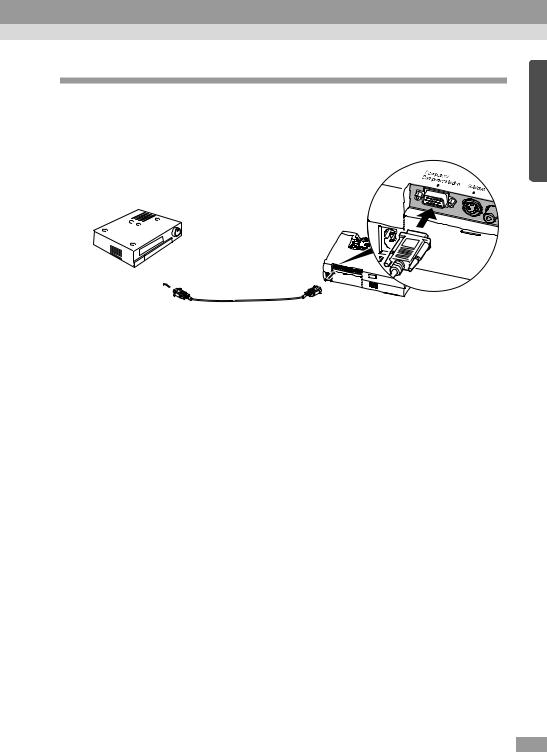
Projecting RGB Video Images
RGB video is used when RGB signals that have copy protection added are input and projected. Use the accessory computer cable to connect the video source to the Computer/Component Video port on the rear of the projector.
To RGB output port
Computer cable |
To Computer/ |
(accessory) |
Component Video port |
Tip :
•Change the "Input Signal" setting in the "Video" menu to "RGB" after making the connections. (p.47)
•For a RGB connection, a commercially available adapter or converter cable might be required.
25
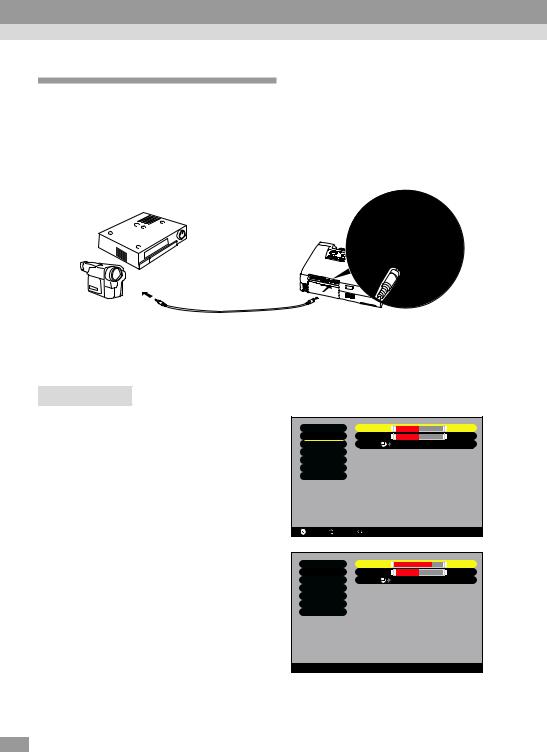
Connecting to a Video Source
Playing Sound from the Video Equipment
The projector has a single built-in speaker with a maximum output of 1 W. You can output sound from the video equipment through the projector's speaker by connecting the video equipment's audio output port and the Audio-In port (stereo mini jack) at the rear of the projector using a stereo mini jack audio cable (commercially-available). It is recommended that you use an audio cable with a 3.5 mm diameter stereo mini jack.
To audio output port |
|
Stereo mini jack audio cable |
To Audio-In port |
(commercially-available) |
|
Use the following procedure to adjust the volume of the sound output.
Procedure
1 Press the [Menu] button on the remote control, and then select "Volume" from the "Audio" menu.
For details on this operation, refer to "Using the Configuration Menus". (p.56)
2 Use the [ ] and [
] and [ ] buttons to adjust the volume.
] buttons to adjust the volume.
The volume is increased or reduced each time a button is pressed.
Video |
|
Volume : |
10 - |
+ |
|
Audio |
|
Tone |
: |
0 - |
+ |
Setting |
|
Reset |
|
Execute |
|
User's Logo |
|
|
|
|
|
Advanced |
|
|
|
|
|
About |
|
|
|
|
|
Reset All |
|
|
|
|
|
: Return |
: Select |
: Adjust |
|
|
|
Video |
|
Volume : |
15 - |
+ |
|
Audio |
|
Tone |
: |
0 - |
+ |
Setting |
|
Reset |
Execute |
User's Logo |
|
|
|
Advanced |
|
|
|
About |
|
|
|
Reset All |
|
|
|
 : Return
: Return : Select
: Select  : Adjust
: Adjust
3 After making the adjustment, press the [Menu] button to exit the configuration menu.
26

Basic Operations
This chapter describes basic operations such as turning projection on and off and adjusting the projected images.
Turning On the Projector .................................................. |
28 |
• Connecting the Power Cable............................................................... |
28 |
• Turning On the Power and Projecting Images.................................. |
29 |
Turning Off the Projector .................................................. |
31 |
Adjusting the Screen Image ............................................. |
33 |
• Adjusting the Image Size..................................................................... |
33 |
• Adjusting the Image Angle and |
|
Automatic Keystone Correction Function....................................... |
34 |
• Manually Correcting Keystone Distortion ........................................ |
36 |
Adjusting the Image Quality ............................................. |
37 |
• Focusing the Screen Image.................................................................. |
37 |
• Adjusting Computer Images............................................................... |
37 |
• Automatic Setup................................................................................................ |
37 |
• Adjusting the Tracking...................................................................................... |
38 |
• Adjusting the Sync............................................................................................ |
39 |
• Selecting the Colour Mode.................................................................. |
40 |
27

 Turning On the Projector
Turning On the Projector
Turn on the power to start projecting images.
Caution :
Be sure to read the separate Safety Instructions/World-Wide Warranty Terms before projecting images.
Connecting the Power Cable
Procedure
1 Check that the power is turned off for the projector and all components connected to the projector.
2 Connect the computer or other video source to the projector. (p.17, 23)
3 Remove the lens cover.
Place your finger under the top of the lens cover and pull to remove the cover.
4 Connect the accessory power cable to the projector.
Check that the power cable connector is facing the same way as the power inlet on the projector, and then insert the power cable connector securely into the projector.
5 Connect the other end of the power
Lit orange
cable to an earthed electrical outlet.
Wait until the Power indicator lights orange.
Tip :
The projector's control panel and remote control buttons cannot be operated while the Power indicator is flashing orange.
28
